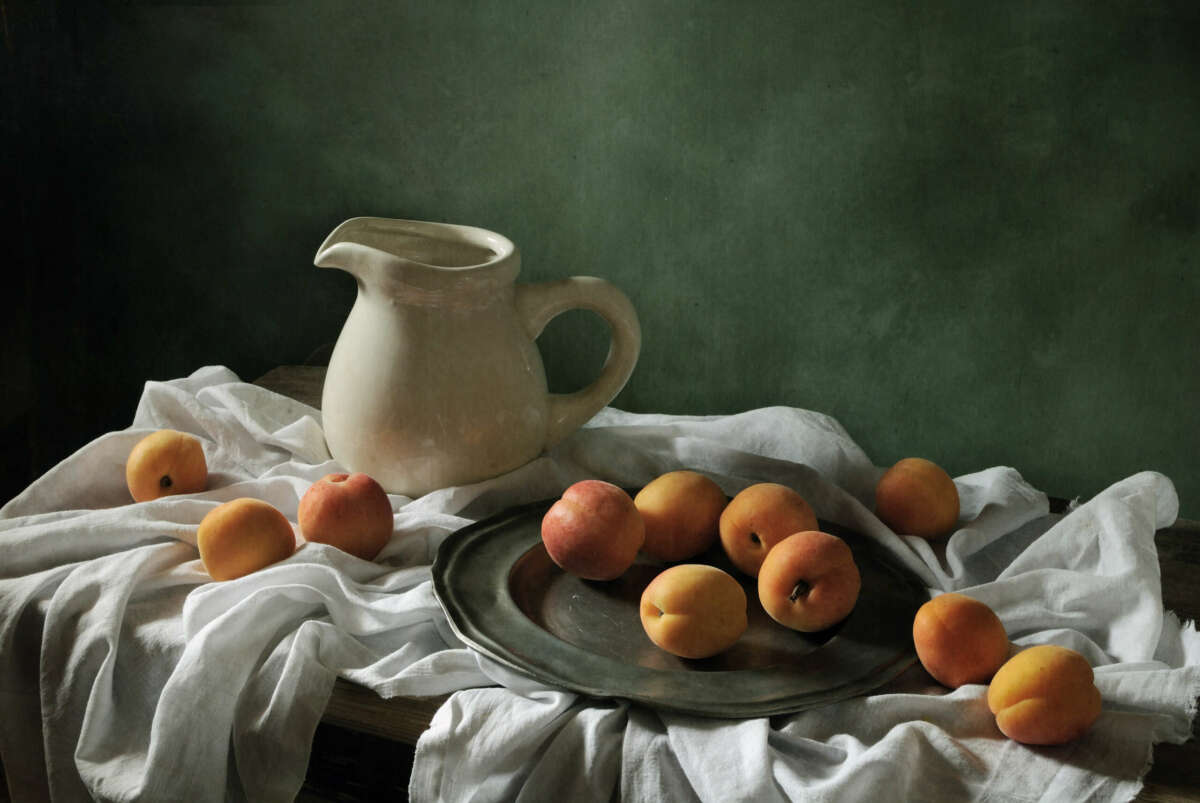With the feasting season upon us, it seemed like the perfect moment to turn our attention to how brilliant artists throughout history have portrayed food, simple meals, and feasting. What role has food and dining played in great art? And how about art that’s actually made of food? Hungry for knowledge? Come along, dear reader. Here are some of the most famous and provocative works of art about food, simple meals and feasting that caught our eye when we went exploring.
Note: originally published in November 2019, updated November 2022
exhibits about food are a consistent presence at art museums and shows around the world
Art museum exhibits about food, dining, and drink are a perennial element of the art world rotation. At any given moment, somewhere in the world there always seem to be 2-3 important exhibitions that take food as a central concern. Playful, provocative, sensual, soothing or enraging, what we eat, where and with whom is a recurring motif in the art of the world.
We recently shared our adventures at a temporary art exhibit from British artist Lucy Sparrow, Lucy’s Deli on Sixth in midtown Manhattan. In it, an entire delicatessen was recreated with felt food of almost every imaginable type.
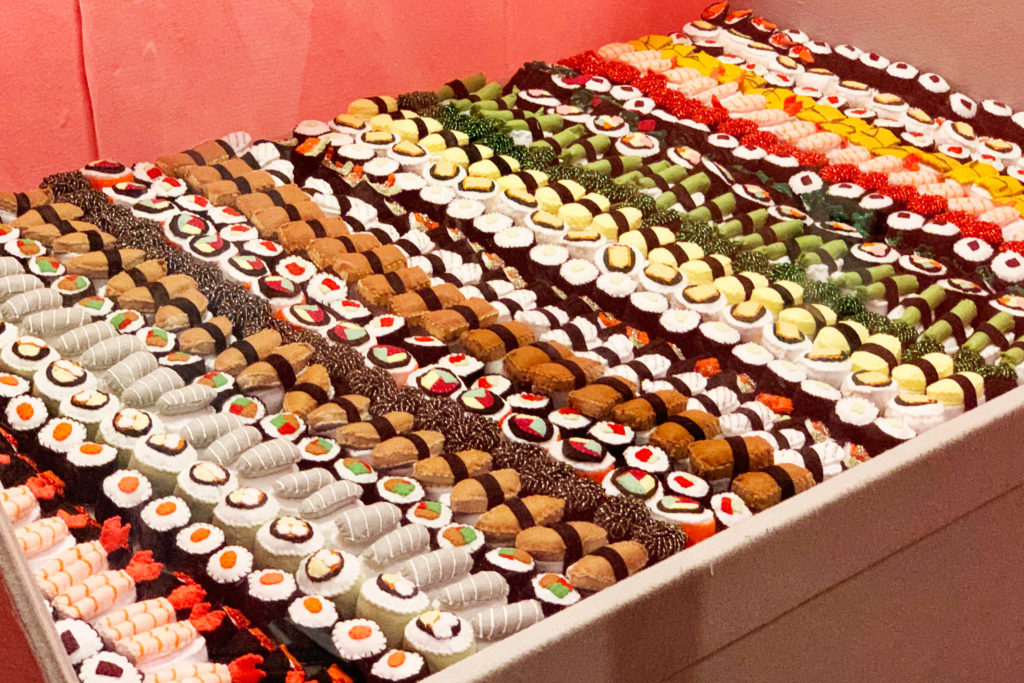
Notable artist’s portrayals of food, and famous and provocative works of art with food, meals and feasting. The sushi counter at Lucy Sparrow’s Deli on Sixth exhibit in September 2019. Photo Credit: Dandelion Chandelier.
For many visitors, the hand-sewn felt works evoked the simple innocence of childhood, the pleasure and abundance of a well-stocked American grocery store. And the tactile joy of soft cuddly felt — and holding something pretty that was made by a human, not a machine.
current exhibits circa 2019
Fundamental to our existence, food is an endlessly interesting subject for artists. At the moment, there are at least three such exhibits or shows underway.
Feast and Fast: The Art of Food in Europe, 1500-1800
The exhibit Feast and Fast: The Art of Food in Europe, 1500-1800 at the Fitzwilliam Museum in Cambridge, UK, opens today and continues through April 26, 2020. The entrance to the museum is graced by a giant pineapple. And one of the works on display is a painting that previously hung in a student dining room on campus. The Fowl Market was removed because vegetarians and vegans found it offensive.
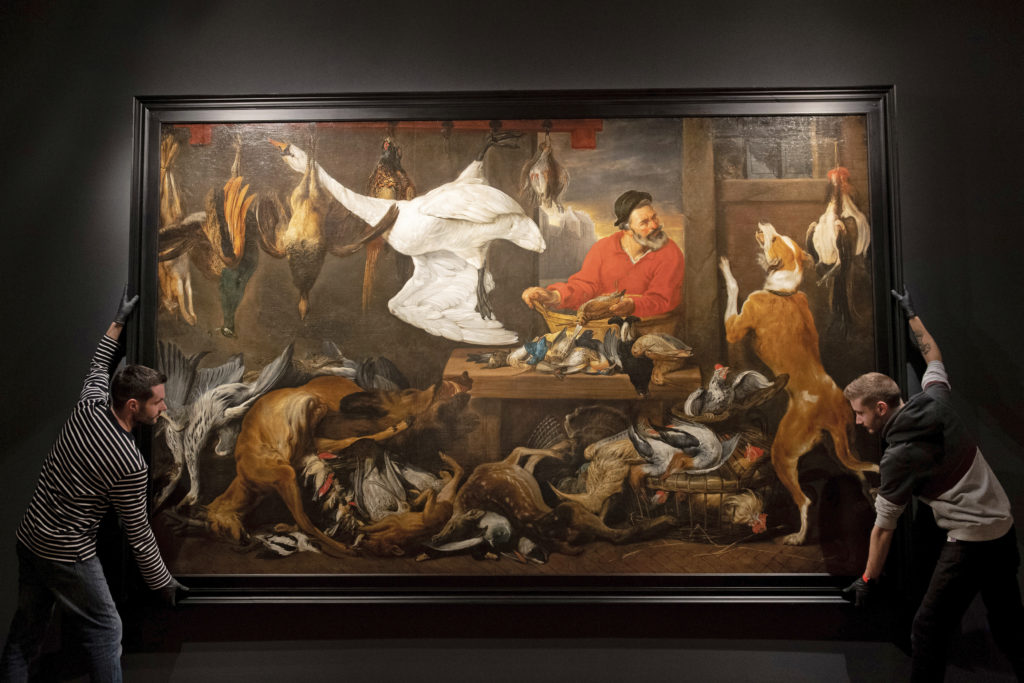
Famous and provocative works of art with food. Frans Snyders’ workshop copy of The Fowl Market at the Fitzwilliam Museum in Cambridge. Photo Credit: Joe Giddens/PA Wire URN:48482931 (Press Association via AP Images)
the Faena Festival: The Last Supper
Across the pond and culturally worlds away from the UK, there’s a different kind of art exhibit about food and feasting. Running from December 2 – 8, 2019, the Faena Festival: The Last Supper at Art Basel Miami Beach features several contemporary works that explore “spirituality and food, abundance and sacrifice, indulgence and abstinence.”
One of the notable works? Berlin-based Nigerian artist Emeka Ogboh has developed a honey brown ale with notes of lime and pepper. The work contemplates “how gustatory experiences capture existential relationships, including immigration and globalization.”
Julie Bozzi: American Food
Meanwhile, in Fort Worth, Texas, the Modern Art Museum is showcasing Julie Bozzi: American Food through February 2, 2020. Bozzi’s sculptural installation consists of an oak cabinet with 13 drawers, 12 of which contain miniature reproductions of American food products. As with the art of Lucy Sparrow, each piece here is carefully handmade by the artist. Bozzi notes that she intends the work to be read as a statement about American consumerism and its culture of abundance.
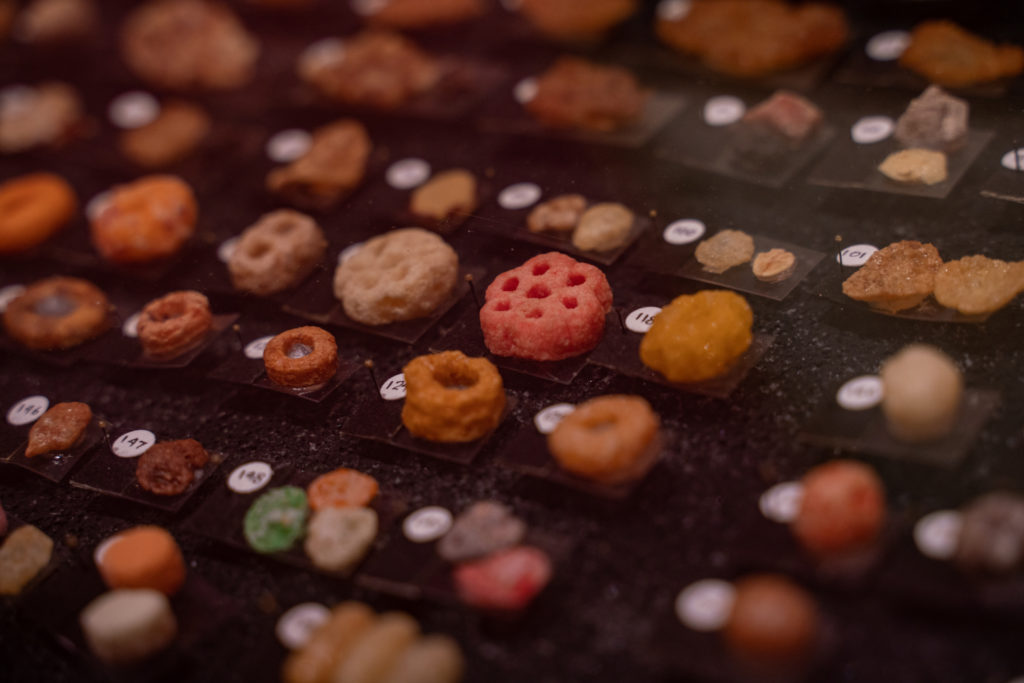
Famous and provocative works of art with food: Julie Bozzi exhibit about American food at the Fort Worth Museum of Modern Art. Courtesy Photo.
museums dedicated to art about food and art made from food
There’s a meaningfully-sized sub-genre of museums devoted to the role of food in art. Some provide a broad overview, with rotating special exhibits. Others go very deep on one specific food item.
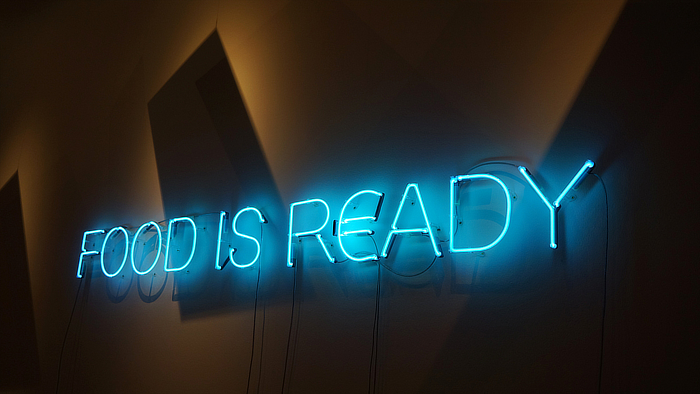
Famous and provocative works of art with food: Emeka Ogboh “Food is Ready.” Courtesy Photo.
For example, there’s The Museum of Food and Drink in New York; The Disgusting Food Museum in Malmo, Sweden. The Frietmuseum in Bruges, Belgium, which is all about the French fry.
what uses have artists had for food, feasting and simple meals?
All of this discussion about fashion and time got us to thinking: what are the most famous and provocative works of visual art about food, simple meals or feasting? What can art show us about the role of food in our lives, and how communal meals and solo dining affect our spirit?
Is this often-quoted sentiment actually true? “Tell me what kind of food you eat and I will tell you what kind of man you are.”
food as a reminder of mortality
Many works of art, whether paintings, sculptures or installations, serve as a reminder of the looming specter of death and human mortality.
meals as a status signifier or a core element of identity
On a more positive note, though, art about food can also celebrate life and human identity. We are what we eat and, equally, what we don’t eat. When, where, why, how and with whom we eat are crucial to our identities.
food as way of celebrating or critiquing national culture
Some works of art about food, especially Pop Art, are meant to be a statement about American consumerism and its culture of abundance.
food as a source of joy and community
Finally, and most appropriately for the holiday feasting season, art about food invites us to break bread together, and posits the shared meal or prayer as the crux of social interaction and communal connectivity.
The most famous and beautiful works of art featuring food, meals, and feasting
1. Bakery Case (1996), Wayne Thiebaud.
Wayne Thiebaud is an American painter widely known for his colorful works depicting commonplace objects, many of them food-related. Pies, ice cream cones, pastries, and hot dogs have all been the subject of his work.
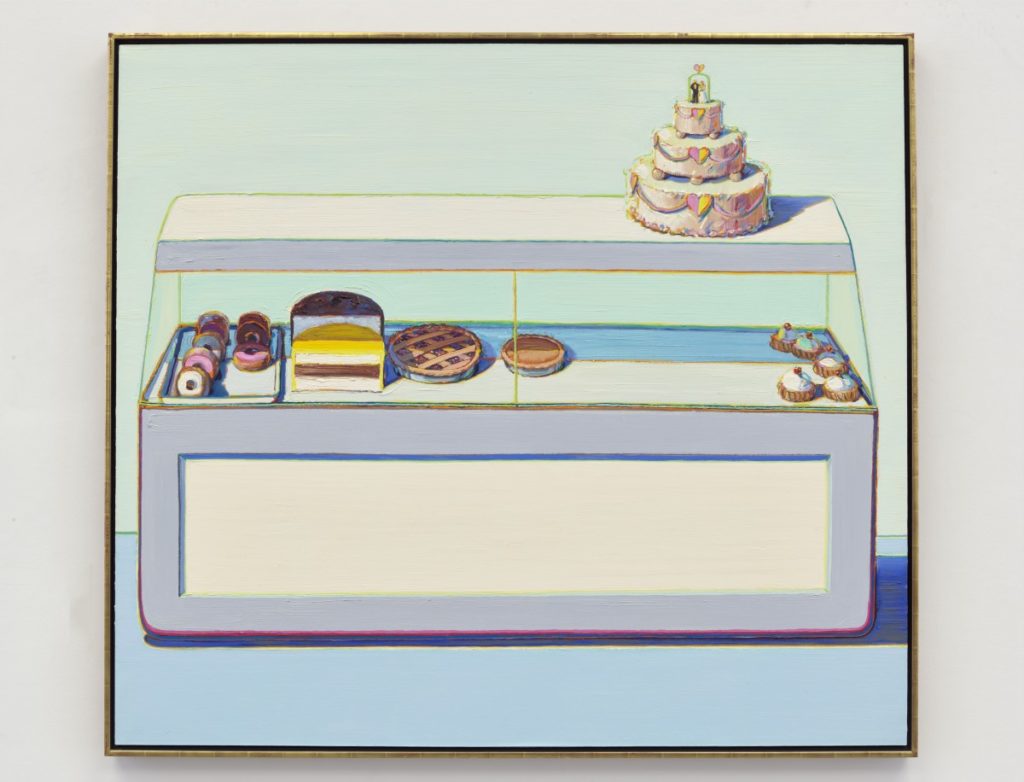
Notable artist’s portrayals of food, and famous and provocative works of art with food, meals and feasting. Wayne Thiebaud, Bakery Case (1996). Courtesy Photo.
One of his best-known and thought-provoking works is Bakery Case (1996). In it, the bakery case exemplifies the unattainable. The depiction of food and consumer goods behind shop windows or cases makes them both simultaneously omnipresent and completely out of reach. Tempting but ultimately unsatisfying. juxtaposes the ideas of abundance and scarcity.
2. Still Life with Ginger Jar and Eggplants (1893-94), Paul Cézanne.
On display at the Metropolitan Museum of Art in New York, this still life typifies how a still life can be an exploration of color, shape and pattern. Using commonplace objects, the artist evokes a mysteriously strange and compelling world.
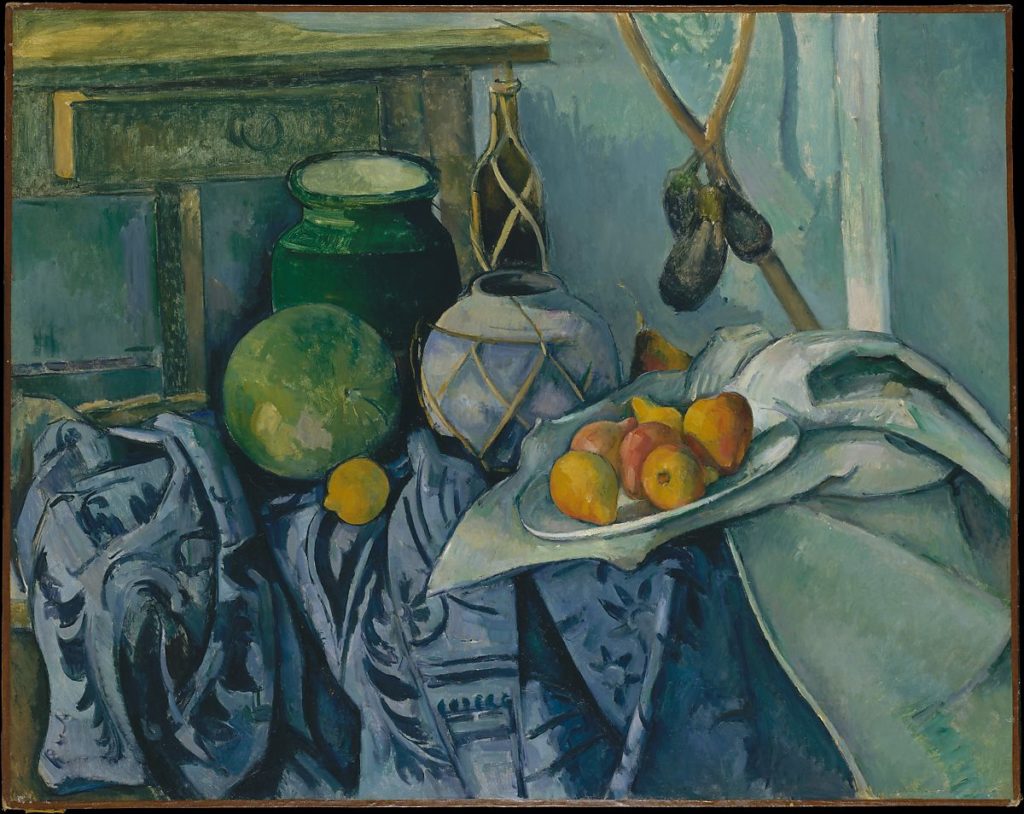
Famous and provocative works of art with food: Cezanne, Still Life with Ginger Jar and Eggplants.
3. Retrospective Bust of a Woman (1931), Salvador Dalí.
Retrospective Bust of a Woman, currently on display at the “new” Museum of Modern Art (MoMA) in New York is a far more provocative work of art employing food. The museum’s notes make clear that the sculpture “not only presents a woman as an object, but explicitly as one to be consumed.”
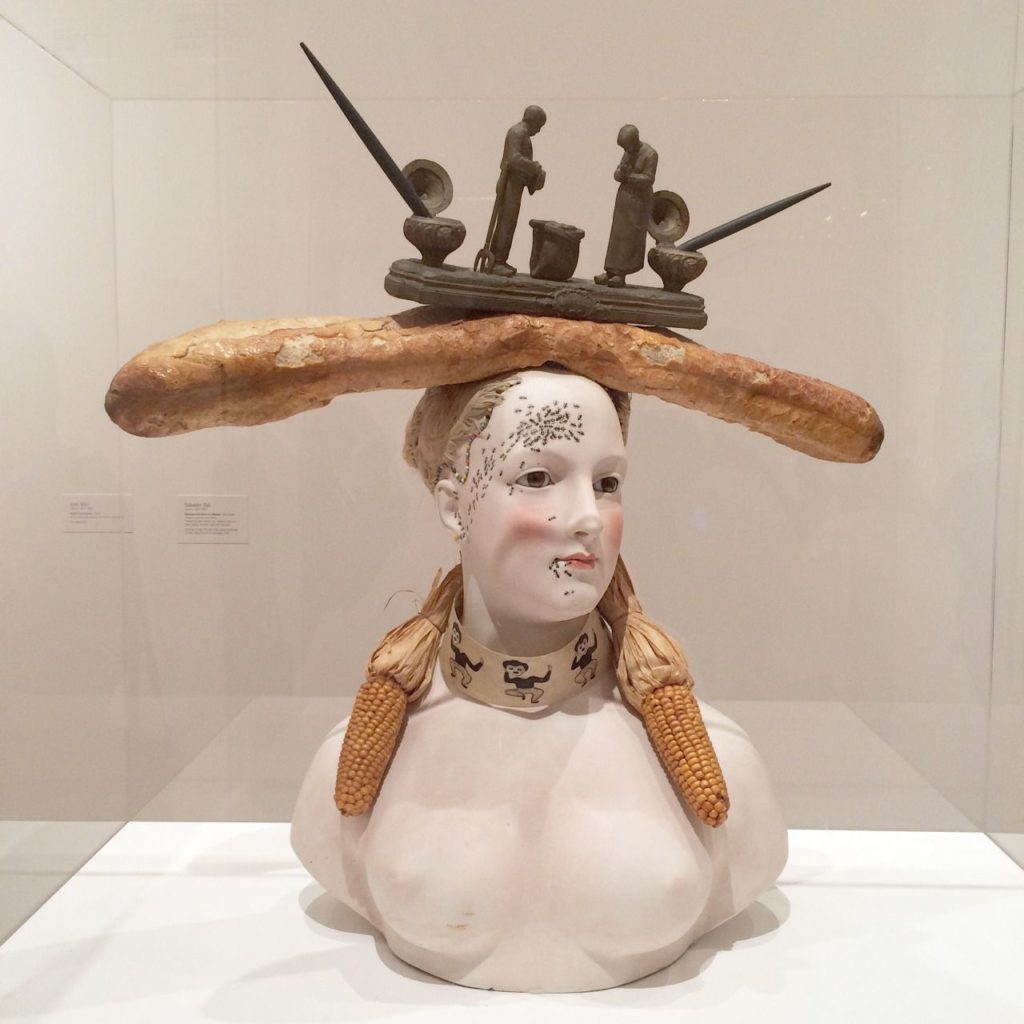
Notable artist’s portrayals of food: Salvador Dali, Retrospective Bust of a Woman.
A baguette crowns her head, corn cobs dangle around her neck, and ants swarm along her forehead as if gathering crumbs.
4. The Dinner Party, Judy Chicago.
The Dinner Party, now on permanent exhibit at the Brooklyn Museum, is widely regarded as the first epic feminist artwork. It functions as a symbolic history of women in civilization. The work depicts a massive ceremonial banquet with 39 elaborate place settings arranged along a triangular table for 39 mythical and historically famous women.
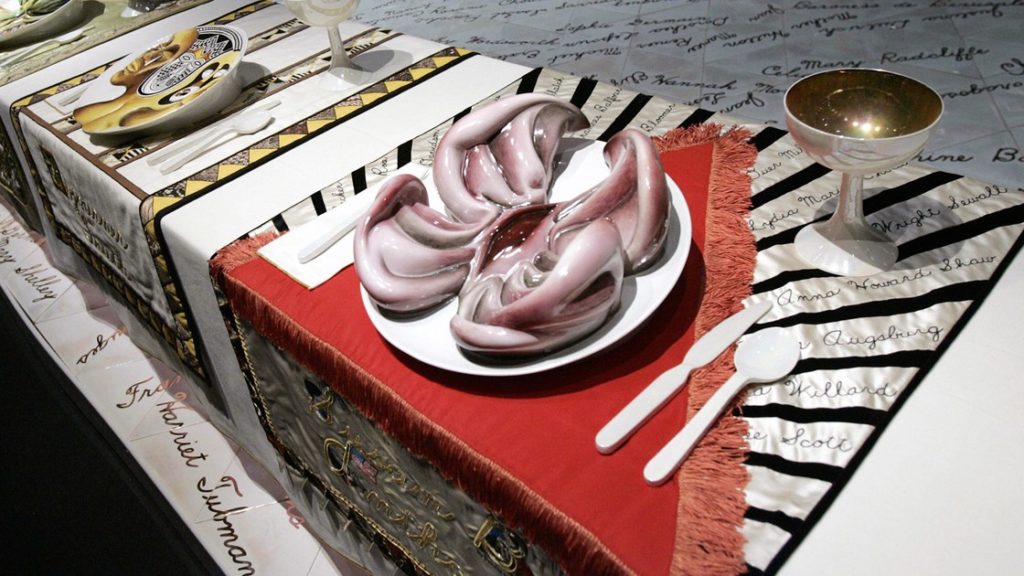
Notable artist’s portrayals of food: Judy Chicago, The Dinner Party at the Brooklyn Museum
china-painted porcelain plates with raised central motifs that are based on vulvar and butterfly forms and rendered in styles appropriate to the individual women being honored. The names of another 999 women are inscribed in gold on the white tile floor below the triangular table.
5. The Potato Eaters (1885), Vincent van Gogh.
A much earlier rendition of food as social commentary is The Potato Eaters by van Gogh. According to the notes from the Van Gogh Museum, the artist’s intention was that “the painting had to depict the harsh reality of country life. He wanted to show in this way that they ‘have tilled the earth themselves with these hands they are putting in the dish … that they have thus honestly earned their food’.”
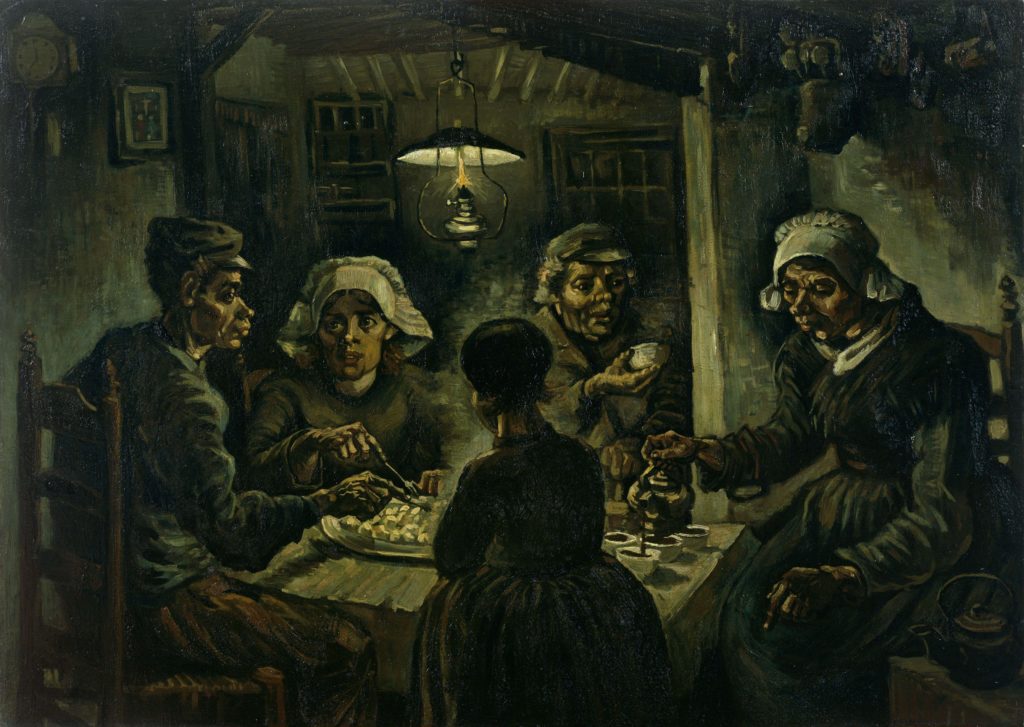
Famous and provocative works of art with food: Vincent van Gogh, The Potato Eaters
He painted the five figures in earth colors – ‘something like the color of a really dusty potato, unpeeled of course’.
6. Floor Burger (1962), Claes Oldenburg.
Everyday food objects can be used subversively – by both the artist and the viewer. playfully surreal sculptures that find new meaning in the everyday objects by expanding them to a gargantuan scale or deflating them into floppy, funny shells. the large-scale soft sculptures Floor Burger, Floor Cone, and Floor Cake, for the 1962 installation of The Store at the Green Gallery in midtown Manhattan.
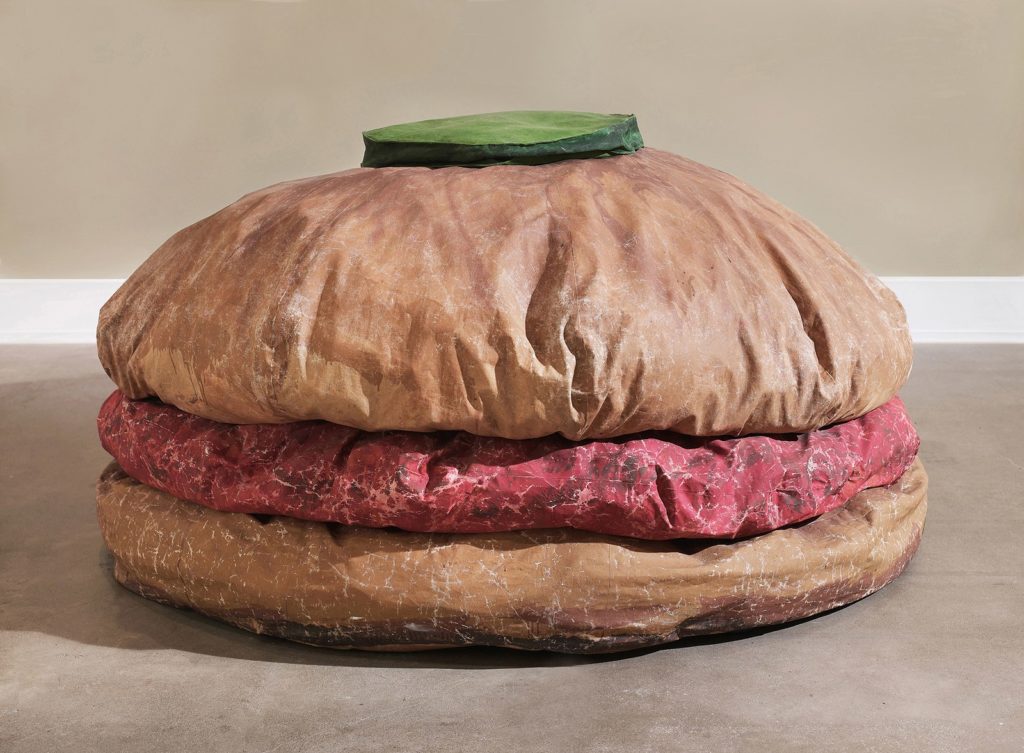
Famous and provocative works of art with food: Claes Oldenburg, Floor Burger (1962).
These large objects were inspired by seeing grand pianos on 57th Street or automobiles in showrooms. Things that were large within a store that you would think shouldn’t have such large things in it. The Hamburger represents Oldenburg’s introduction of soft sculpture. But it caused a great deal of controversy when it was first deemed fine art, with students in Canada protesting the use of public funds to buy a giant hamburger by parading through the streets with a giant ketchup bottle.
7. The Chromatic Diet (1998), Sophie Calle.
French conceptual artist Sophie Calle’s 1998 work “The Chromatic Diet.” In Leviathan, Paul Auster describes his character Maria (based on Calle) : “some weeks she would indulge in what she called the “chromatic diet”, restricting herself to foods of a single color on any given day”.
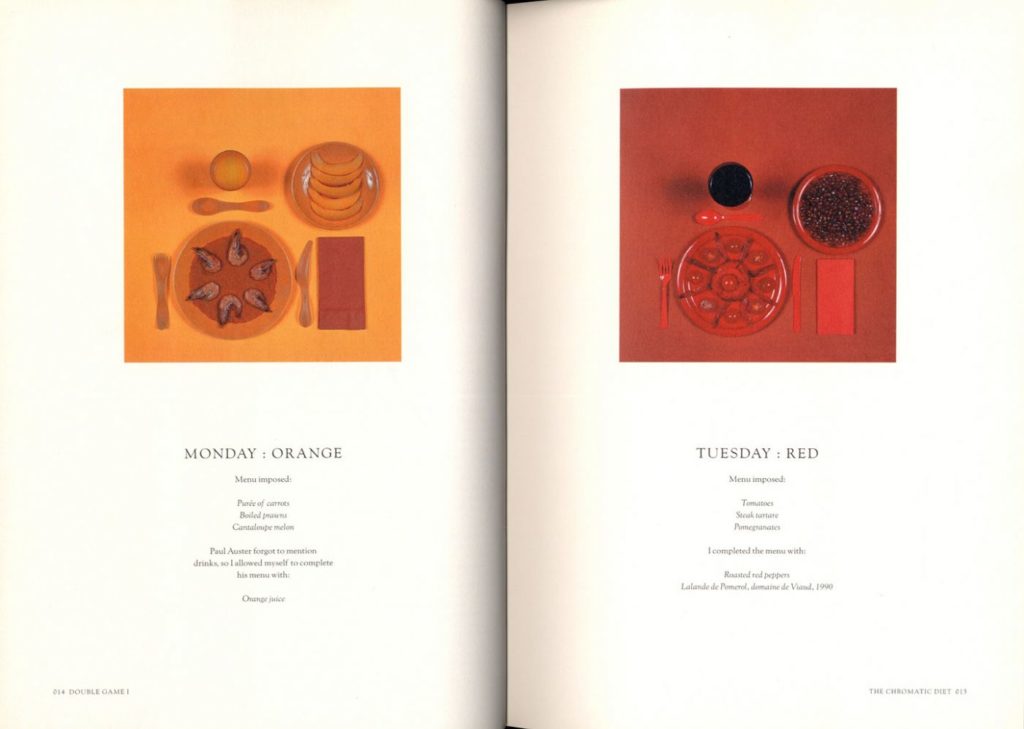
Famous and provocative works of art with food: Sophie Calle, The Chromatic Diet.
In a 1997 photo series called “The Chromatic Diet,”Calle set out to create a meal each day only using ingredients of the same hue. The project is a directly meta response to author Paul Auster’s Leviathan, in which the protagonist (based on Calle) performs this very eating ritual.
8. Untitled (Portrait of Ross in L.A.) (1991), Felix Gonzalez-Torres.
An installation by the Cuban artist Felix Gonzalez-Torres. His Untitled (Portrait of Ross in L.A.) (1991) a 175 pound-pile of candy, from which visitors are encouraged to take samples.
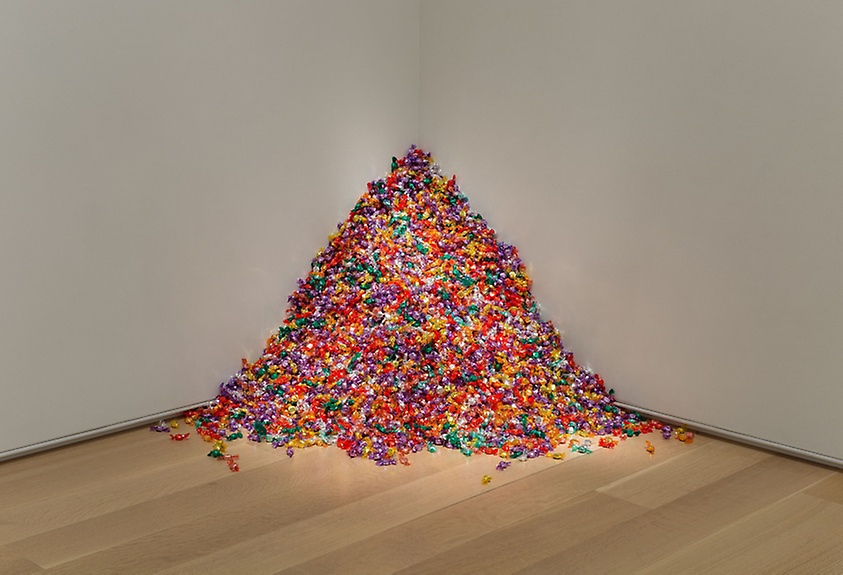
Untitled Portrait of Ross in LA 1991 Felix Gonzalez Torres. Courtesy Photo.
As the 175 pounds slowly diminishes, it mirrors how Gonzalez-Torres’s late partner, Ross Laycock, wasted away until he eventually died of complications from AIDS. (At just 38 years old, Gonzalez-Torres also died from AIDS in 1996.)
9. Strange Fruit (1992-97), Zoe Leonard.
Strange Fruit (for David) was made over the course of five years from the rinds and skin of about three hundred pieces of fruit that the artist and her friends had eaten and then allowed to dry. She “repaired” and adorned the opened seams with colored thread, shiny wires, buttons, and zippers. It began with two oranges sewn in Provincetown and continued in New York and later in Alaska, where she relied on fruit sent to her by mail. Leonard
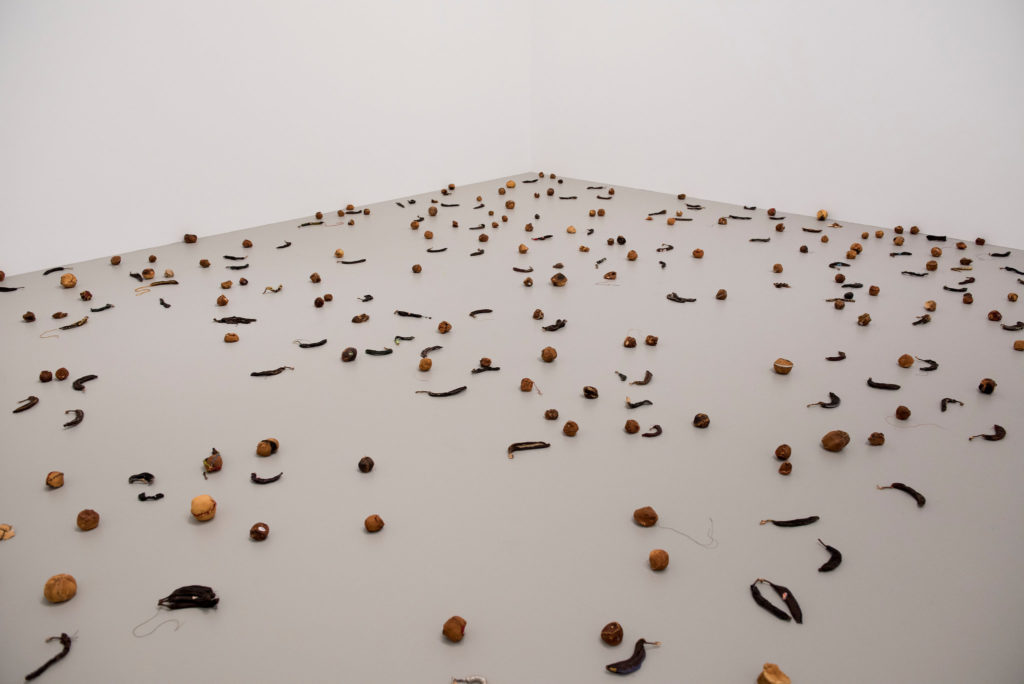
Notable artist’s portrayals of food, and famous and provocative works of art with food, meals and feasting. Strange Fruit Zoe Leonard. Photo Credit: George Etheredge for The New York Times.
Strange Fruit began as a means of consolation for the artist after the death of a friend, but now presents a wide range of possible readings, including a meditation on loss and mortality. The fruit skins—emptied, dried, faded, repaired, and ornamented—have the feel of relics, almost like photographs. Transformed by the artist’s delicate mending, they are subject to effects of time that are as unpredictable as they are inevitable.
10. Who’s Afraid of Red, Yellow, and Green (2010), Rirkrit Tiravanija.
For two months this summer, edible art was on offer at the Hirschhorn Museum in Washington, DC. Who’s Afraid of Red, Yellow, and Green (2010) by contemporary Thai artist Rirkrit Tiravanija united the artist’s signature culinary work with his ongoing series of drawings derived from protest imagery. Through real-time art creation and periodic food service to museum visitors, the artist challenges ingrained ways of interacting with “art.”
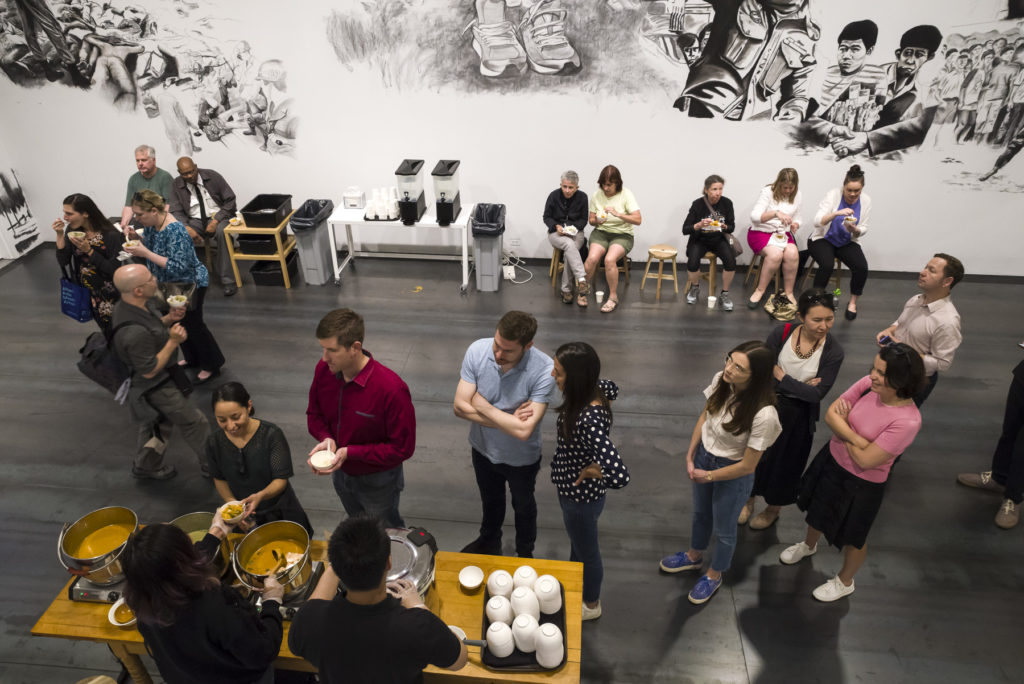
Notable artist’s portrayals of food, and famous and provocative works of art with food, meals and feasting. Rirkrit Tiravanija (who’s afraid of red, yellow, and green) at the Hirshhorn Museum and Sculpture Garden. Courtesy Photo.
transforms the Hirshhorn’s galleries into a communal dining space in which visitors are served curry and invited to share a meal together. The installation includes a large-scale mural, drawn on the walls over the course of the exhibition, which references protests against Thai government policies.
11. The Basket of Wild Strawberries by Jean Baptiste Simeon Chardin.
At a spring 2022 auction, a work featuring food shattered a global record with its sale price. The Basket of Wild Strawberries, painted by 18th-century French artist Jean Baptiste Simeon Chardin sold for $26.8 million. Art Newspaper reported that it was the most ever paid for an 18th-century French painting at auction.
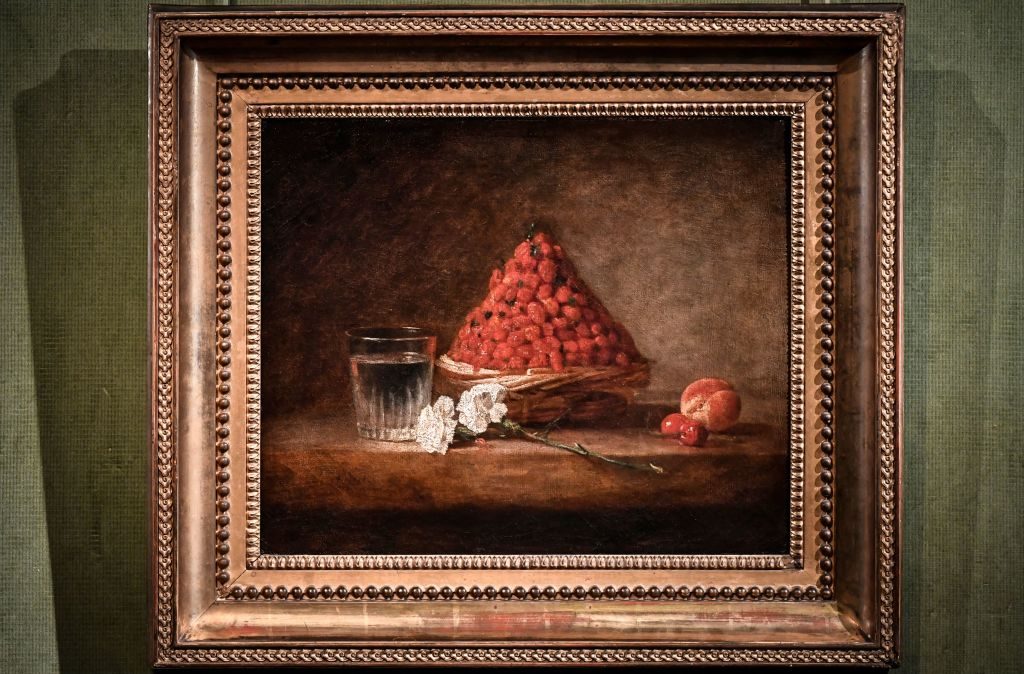
Notable artist’s portrayals of food, and famous and provocative works of art with food, meals and feasting. Photo Credit: Getty Images.
Chardin painted approximately 120 still lifes over the course of his life, often with the same objects: goblets, teapots, hares, plums, melons, and peaches. This is the only one, however, that featured strawberries. The work was originally exhibited at the Salon of 1761. Chardin’s work influenced many of the great painters who followed him, including Cézanne and Manet. Striking in its simplicity, this work came to represent the height of artistry in the 18th century in France.
12. Black Woman with Chicken (1987-88) by Carrie Mae Weems.
Carrie Mae Weems is best known for her searing and tender photographs and videos exploring race, family, class, and gender identity. Her iconic “Kitchen Table” series depicts the artist seated at her kitchen table alone, or alongside various other characters. In subtle ways, they tell stories about Black life that upend conventional expectations.
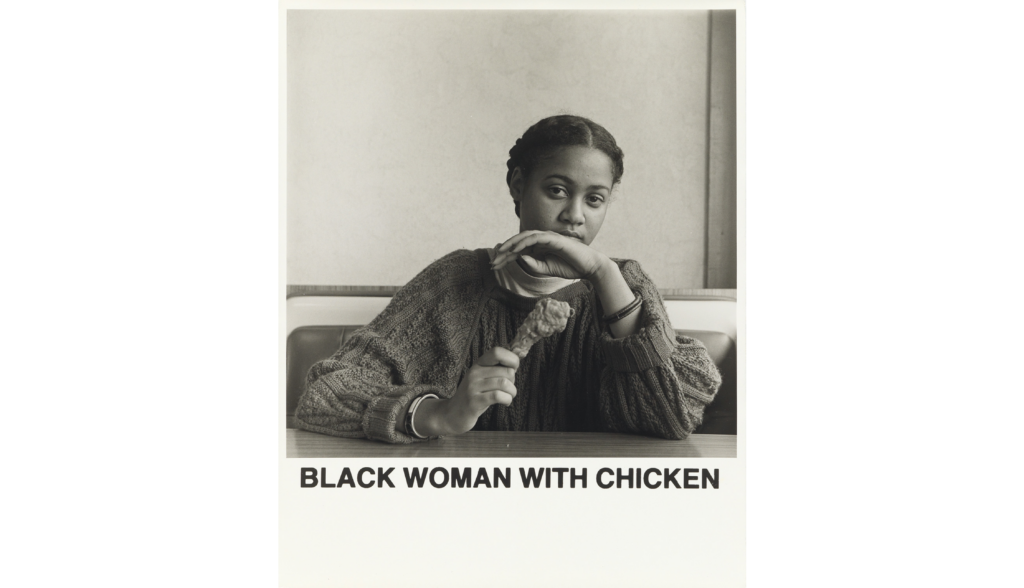
Photo Courtesy the artist and Jack Shainman Gallery.
This work is from her early series of photographs, “Ain’t Joking.” The juxtaposition of the grave beauty of the woman’s face and the fried chicken leg, commonly associated in a derisive manner with Black people and culture, is stunning.
13. Comedian (2019), Maurizio Cattelan.
Perhaps the most recent infamous example of art made from food is the “Art Basel Banana.” Actually entitled Comedian, the work by Italian artist Maurizio Cattelan consisted of a ripe banana duct taped to a wall. It sold for $120,000 and was the source of a media and Twitter frenzy that far surpassed what any other work shown that year garnered.
Is it an homage to comedians throughout history slipping on banana peels? Is it even art? One gallery owner summed it up best in an interview with Vogue. “Wasn’t it Warhol who said ‘Art is whatever you can get away with’?”
In an interesting footnote, before the air fair ended, performance artist David Datuna casually strolled up to the work and ate the banana.
14. Culinary Art Paintings, Carrie Mae Smith.
We recently discovered the work of Carrie Mae Smith, a visual artist who is fascinated by food and the culinary arts. Some of the artist’s portrayals of food are traditional, while others are art about food with a modern take. For instance, some portray raw meat in all its shades of pink and crimson. Others present a refined look at desserts like cream puffs and tiramisu. All of them have a timeless, dreamlike quality that evokes personal memories of meals shared. And an appreciation for the hard work it takes to put food on the table.
The artist notes: “On my path to becoming an artist, I worked as a private chef and caterer, combining my love of color, form and texture with taste. The many hours I spent working with food and table settings led me, quite naturally, to using it as subject matter in painting.”
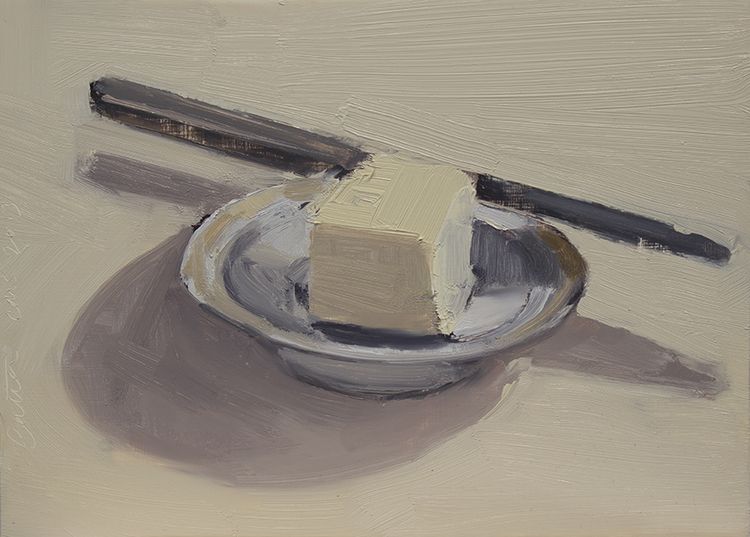
Photo courtesy the artist and gallery.
the most famous and beautiful works of art with food, meals and feasting
That’s it – some of the most famous, unusual and provocative artist’s portrayals of food, simple meals and feasting. Which one speaks most compellingly to you, dear reader? And out of the thousands of other works of art featuring food, which one is your favorite?
